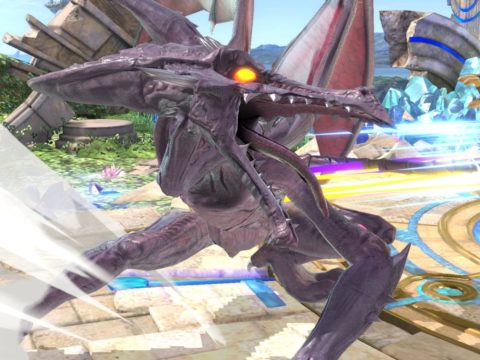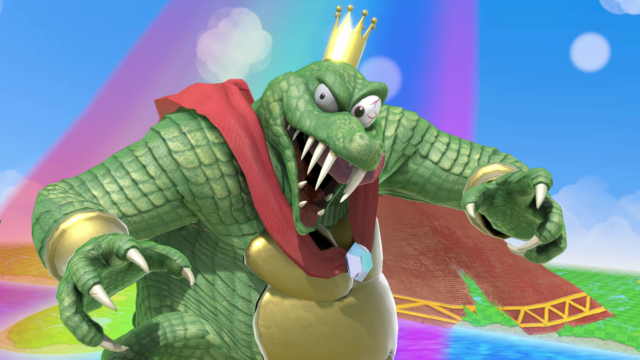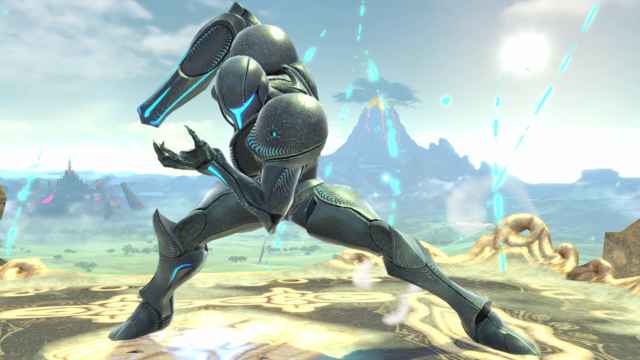Pristine precision gameplay; uncanny roster that offers the best fan service anyone could hope for; incredible variety of music, stages, items, and more; virtually limitless replay value
Online play is more inconsistent than is acceptable; lack of Trophies goes against the grain of what Smash Bros. is all about
Super Smash Bros. Ultimate has certainly done a good job of hyping itself up as the, ahem, “ultimate” game in the series. Boasting a roster of over 74 fighters (amazingly, not including DLC), the tagline “Everyone is here!” has been displayed prominently on Ultimate‘s marketing materials for good reason. This is the largest assemblage of fighters yet seen in any Smash Bros. game, but it represents much more than just a rich selection of brawlers to choose from. Ultimate is a milestone achievement in terms of uniting some of the biggest franchises and characters in the industry. What’s more, Ultimate is also the pinnacle of the series, providing the most accessible and enjoyable gameplay to date.
Smash Bros. games have a very simple premise: two to four (and in this case, up to eight) players duke it out in an effort to knock one another past the boundaries of the TV screen. As blows are exchanged, each fighter’s damage percentage rises; the higher the percentage, the more easily an opponent can be launched into the air and knocked out. Smash Bros. utilizes a simplified two-button control setup that provides for a much lower learning curve than the average fighting game. In order to do different attacks, players simply tilt or flick the control stick in one of four directions while pressing either of the two buttons. It’s easy to learn and yet still affords a great deal of intricate battle strategizing to the player. It’s this mix of creative knockout mechanics and accessible controls that has made Smash Bros. a delight for years now.
For Ultimate, Nintendo and series director Masahiro Sakurai have genuinely outdone themselves. Pundits and pro/semi-pro Smash players will have their opinions on the actual balance of the fighters, but from the perspective of someone who is simply a ravenous fan of the series, Ultimate has almost everything anyone could want. The roster alone is easily the greatest any Smash Bros. game has ever offered. Without exception, every character that has ever been in the series is back for Ultimate. Seeing icons like Mario, Sonic, Cloud, Snake, Pac-Man, and countless others slugging it out on the same screen is astounding to behold. It’s important to keep in mind that yes, Smash Bros. is a fighting game, but it’s also a legitimate celebration of Nintendo and all of the other franchises from outside the company that elect to participate.
Sadly, some of that celebratory aspect of Smash Bros. has been lost in Ultimate because of the absence of Trophies. The collectibles have been a part of the series since Super Smash Bros. Melee on GameCube, providing a combination of 3D models to gawk at and brief anecdotes alongside historical blurbs about that particular character, item, etc. Trophies were a brilliant incentive to get players to keep coming back for matches and to complete different objectives, as these activities tended to result in being rewarded with one of the trinkets— collecting them all was almost a game unto itself. Ultimate has done away with Trophies (Sakurai alleges that they required too much work to be made), however, and has largely attempted to replace them with Spirits. We’ll talk about Spirits in detail in a bit, but they are unfortunately not a suitable replacement for the loss of Trophies from a collecting and historical standpoint. It’s a small omission in the grander scheme of what Ultimate has to offer but, for longtime fans especially, it’s a major bummer.

Since we’re on the subject, though, I don’t want anyone to think that Spirits in and of themselves are not a worthwhile addition to the franchise. Ostensibly, Spirits are to Ultimate what Stickers were to Super Smash Bros. Brawl. Spirits come from every game series represented in Ultimate and can be almost any character that a player can imagine. From Spring Man to the Elite Beat Agents, there are a ton of Spirits to unlock from playing Classic mode and the new World of Light adventure mode, as well as by completing Challenges. Each Spirit is essentially a buff of some kind. There are two types of Spirits to utilize: Primary and Support. Primary Spirits help to increase a fighter’s attack stat, while Support spirits provide a variety of complimentary effects, such as increased jump height or starting a match with a certain item equipped. Each Primary Spirit has an assigned number of slots available in which to plug in a Support Spirit, so players are able to customize until they find a combination that suits their fighting style.
Spirits can also be leveled up, which allows them to become even more powerful and advantageous during bouts. They’re featured most prominently in World of Light, but they can also be incorporated into regular fights. For Smash Bros. purists, Spirits might not be quite as appealing, as they ultimately alter a fighter’s base performance quite substantially. Yet, that will likely be a big part of the allure for fans who do want to customize the different combatants to their tastes. The possible combinations of Spirits is dizzying, and also adds another layer of randomness to the proceedings, making fights more interesting than ever. As Spirits are entirely optional, no one is forced to use them, but I do recommend giving them a whirl if you’ve been doubting the concept from the outset. It’s a fully-fledged feature that clearly a lot of thought was put into, and it’s arguably more intuitive and engaging than Stickers ever were in Brawl.

Tethered to these Spirits are the fighters themselves. I lavished praise on the roster earlier, but a key difference this time around is the fact that only the original eight members of the first Super Smash Bros. on Nintendo 64 are available from the outset. That’s Mario, Donkey Kong, Link, Samus, Yoshi, Kirby, Fox, and Pikachu. What follows from the moment players begin fighting in Ultimate, whether it’s in Smash battles or any other mode, is a very long series of character unlocks. There are all sorts of tricks and techniques being bandied about on the internet about how to increase the frequency at which fighters become accessible in Ultimate, but ignoring those exploits, if played straight… well, even then it’s hard to peg exactly how long the process is! All game modes offer new fighters, but there’s no apparent rhyme or reason as to which characters appear and when. There’s also no way to definitively label whether the sheer amount of unlocks required to obtain the full roster in Ultimate is a good or bad thing. It is what it is, as they say, but at least be aware going in that no one will be able to start Ultimate with a full roster.
Ultimate has a number of modes for players to explore to help speed up the unlock process and expand the overall experience. Classic Mode is the usual gauntlet that fans have come to expect, although this time around certain characters have more specialized tracks than others. Spoiler alert: Simon, for instance, battles Dracula as his final boss, while other characters simply do battle with Master Hand at the end. Seeing which characters fight which bosses is a big part of the fun, although it would’ve been nice to see a tad more unique final foes for a larger chunk of the roster. Adventure Mode, meanwhile, is where World of Light is housed, the epic, sprawling campaign that was shown off in the last Smash Bros. Direct broadcast. It is indeed packed with stages as well as fighters and Spirits to unlock, but don’t expect a new version of the Subspace Emissary from Brawl. This is the game’s story mode, but it’s fairly light on narrative. Still, it’s fun nonetheless and provides hours of gameplay that helps break up the grind of basic multiplayer matches, which in turn serves to help balance out Ultimate as a whole.

Smash Mode, meanwhile, is where most players will likely immediately gravitate to. It’s here that all of the offline-multiplayer shenanigans take place. There are the usual basic multiplayer fights to take part in, but there are also Special Smash, Squad Strike, and Tourneys to enjoy, too. Special Smash offers Smashdown, where players run through the entire roster of fighters, and Custom Smash, where all sorts of parameters in fights can be customized. Squad Strike, on the other hand, is where teams can be arranged in groups of three or five and then opponents take each other on one at a time. Tourneys, finally, are bracketed affairs (which can be customized) where up to 32-combatants can register. There’s also the customary suite of options like the ability to shut off items, change the number of stock lives, and so on, in order to fine tune matches exactly how players want them to be. The addition of Battlefield versions of each stage is also welcome. After factoring in the wealth of customizable control/controller options, Ultimate is arguably the most user-friendly fighting game ever made.
Online is another story, however. Local Wireless, where multiple Switch consoles are linked together without utilizing an Internet connection, works fine. Gameplay is smooth and adding into/dropping out of matches is similarly fluid. It’s when the action goes online that things start to get rough. While playing via a network connection, up to four other combatants can join in. Matchmaking is based on each player’s Global Smash Power, a ranking that basically gauges how adept each fighter is at playing Smash Bros. From there, players can set up their preferred rules, including things like whether they want to play one-on-one or in a group, with items or without, and so on. The game then arranges combatants accordingly as closely as it can based on those factors, and opponents have at it. Sadly, as of this writing with Version 1.2.0 of Ultimate live, online matches remain shaky.

Sometimes matches are silky and everything runs just like it should. Other times, and frankly more often than they should be, the game simply can’t keep up with what’s happening on-screen. Nintendo has openly advocated for players of Ultimate to go out and purchase a LAN wired Internet adapter in order to make their Switch’s connection to the web as stable as possible, but even after doing this it has made minimal difference during online play. While Super Smash Bros. for Wii U wasn’t perfect when played online by any means, especially compared to Mario Kart 8, somehow it feels like Ultimate has regressed in comparison to its predecessor. This is particularly egregious when taking into consideration that Nintendo players now have to pay for the Nintendo Switch Online service in order to even battle one another over the internet. Ultimate is easily going to be one of the pillars of connectivity on Switch, yet it has lurched out of the gates in this critical regard.
It’s not all melancholy and sadness. Again, the online play does work in spurts, it’s just not terribly consistent or reliable. Beyond this blemish (and a lack of Trophies), thankfully, there’s not much Ultimate doesn’t do perfectly. This is the best that Smash Bros. has ever been. Ultimate is the perfect place for new fans to become familiarized with the ins and outs of combat, while seasoned vets will revel in the insanely huge roster and the extent of customization afforded by the game. While it easily could have collapsed under the weight of too much content and a lack of direction, Ultimate is instead very cohesive and doesn’t treat a single bit of itself like excess. The only real question at this point is how Nintendo will ever be able to top this iteration of Smash Bros., but that’s a dilemma for another day— until then, Ultimate is, hands-down, a top-three experience on Switch that everyone needs to experience.




 ShareThis
ShareThis





